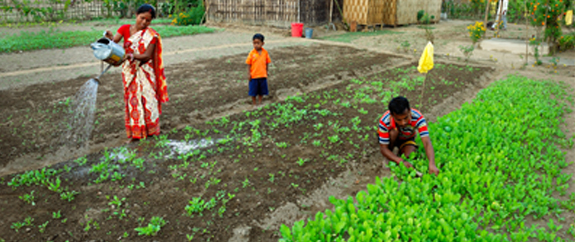
This blog post originally appeared on Devex.
By Sanjoy Patnaik
In his July 26 speech to a packed Safaricom Indoor Arena in Nairobi, Kenya, U.S. President Barack Obama told his audience that “any nation that fails to educate its girls or employ its women and allow them to maximize their potential is doomed to fall behind in a global economy.”
He went on to state that this is “one of the most successful development policies you can pursue.”
Unfortunately, it is also one of the most often missed development policies.
To illustrate how our best of intentions routinely miss the mark and exclude women and girls, I’d like to introduce Ulli Gauda, a 35-year-old single woman from a remote village in Odisha, an eastern province of India.
When we met her, she had been thrown out of her childhood home by her elder brother. A neighbor had taken pity on her and let her live in his cow shed.
My organization had partnered with local officials to identify and count all of the poorest of the poor — the landless poor — in Ulli’s area of the country. What we received back from our field team was thousands of names — the overwhelming majority of them male.
Women like Ulli, our field team and officials told us, generally didn’t count. Why? Because the assumption was that women would be taken care of by their family members.
So we went back into the field and found Ulli and tens of thousands of women like her — young mothers who had been abandoned by their husbands, widows, single mothers — all of them living lives dominated by vulnerability and poverty.
We convinced our government partners that these women deserved to be counted. By counting the thousands of landless women within their jurisdictions, governments can connect them to the resources they need to thrive. A small plot of land on which to live and farm can empower these women to better provide for their families and climb out of poverty.
I’m happy to report that our government partners in a number of districts have begun counting women-headed households and single women, offering them government support services. Indeed, through our partnership, more than 2,000 women have already received secure rights to a small plot of land, giving them security and the opportunity for a better life. Many thousands more have finally accessed other government poverty-alleviation services, such as nutrition and work programs.
It is important to note here that there was no government policy that prohibited women-headed households from applying for government programs. But it was generally the practice to exclude these families.
This is not just a problem for state or local governments. As we have witnessed in our work with a variety of organizations and governments, there is no shortage of well-meaning development projects that have ignored or sidelined women’s issues. For example, one conservation program sought to upgrade soil quality, only to find that once it was improved the men took the land from the women who had been farming the land despite insecure rights to it. In another case, a national government rolled out a national land registry, without specifying that women’s names should be included — prompting officials in some areas to dutifully record only men’s names as heads of household and unintentionally undermining women’s rights to their homes and farms.
The stories are as endless as the lessons are clear: Ignore women’s rights at the peril of development, and more importantly, of the poor.
A bright note on this front is the growing consensus behind incorporating women’s rights and measuring for impact among women in the proposed sustainable development goals, which are set to replace the expiring Millennium Development Goals in September.
While early proposed indicators fell short of providing a full account of progress based on gender, the U.N. Interagency and Expert Group on the SDG indicators released July 7 an updated list of proposed global indicators for the framework’s goals and targets. The group’s indicator for measuring progress related to land rights calls for the collection of data for both men and women.
However, it is critical that the indicator for land measures men and women’s rights separately. Yes, sex disaggregated data is more labor intensive, but we know that it is essential. We know that secure land rights for a man in a given household do not necessarily translate to secure land rights for women in the same household, and we know that if we don’t take steps to ensure women are recognized and included, they will be overlooked on this important measure for women throughout the world.
That would be a tremendous missed opportunity. A wealth of research makes clear that women’s land rights, in particular, is crosscutting and can have a ripple effect that can leverage progress on a number of critical development goals — including child nutrition, poverty alleviation, and women’s social and economic empowerment.
“You know, we’re in a sports center,” Obama said in his speech in Nairobi. “Imagine if you have a team and you don’t let half of the team play. That’s stupid. That makes no sense.”
But getting the whole “team” on the field requires more than just the removal of obstacles for women and girls. It requires the global development community to create policies, programs, goals and targets that intentionally count women — and prioritize their participation.
Sanjoy Patnaik is Landesa’s India Country Director.
